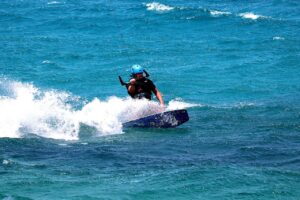Which kiteboard size is right
Every year, many kitesurfers have the problem of determining which size kiteboard is appropriate for their board. What length should my kiteboard be? How wide should my kiteboard be? What width should a kiteboard be?
The selection is not straightforward, particularly for newcomers, as various manufacturers offer kiteboards that range from 130 to 150 cm in length.
The kiteboard size is essential for a quick learning success and fun on the water
This article will assist you in gaining an understanding of the kiteboard industry and locating the best kiteboard for your needs.
Here, in a step-by-step manner, the current kiteboard models are introduced so that you can have a better understanding of what the marketing terminology means. It is simply too time consuming for many kitesurfers to keep up with the most recent kitesurfing gear.
It’s important to note what you want from a new kite board before buying one. It’s also beneficial to quantify the following: your preferred kitesurfing discipline, where you intend to mostly kite, the prevalent wind conditions (wind: knots from/to), and your current kites.
To have the most enjoyable time on the water, your kite board’s size must be adjusted to suit your body weight.
Basic information you should consider before buying a kiteboard
The breadth of a kiteboard is one aspect to consider – the wider, the more stable it is on the water, right? But width is far more essential. Why is that so?
A centimeter more width on a board provides considerably more surface area than an additional centimeter of length. If I give the kiteboard 1 centimeter wider, I get vastly greater projected surface area, as if I gave it 4 cm extra length, especially since the tips are somewhat bent up depending on the rocker.
Narrow kiteboards are more lively and sporty. They don’t glide as quickly, however, and have the worst performance characteristics when holding height or running upwind. If you’re too strong for a regular kiteboard, a wide one isn’t as simple to manage as its narrower brother.
What determines whether you’ll go out on the water when there’s less wind: a larger kite or a bigger board? In this instance, the bigger projected surface of the kite board clearly gives it an edge.
That’s because the wider kiteboard has more surface area for gliding on the water, and the smaller kite can be accelerated more quickly as a result of its turning ability and pulling power.
Here’s a quick rundown of the differences between each size, which you may use as a starting point to determine the best kiteboard size for you. This overview is especially beneficial for novices.
Kitesurfer Weight
50 – 65 kg
60 – 75 kg
70 – 85 kg
85 – 95 kg
> 95 kg
Kiteboard Length
132 – 135 cm
134 – 138 cm
137 – 145 cm
144 – 152 cm
151 – 166 cm
Kiteboard Width
39 – 41 cm
40 – 42 cm
41 – 46 cm
45 – 48 cm
46 – 50 cm
The most common beginner kiteboards
Since this kiteboarding buying guide is for novices, I’d like to show you some “classic” beginner kiteboards. Of course, there are many more models.
One of the best Beginner Kite Boards: Cabrinha Spectrum & Duotone Jaime
The Cabrinha Spectrum was the first board on which I learned to kite. It’s used by several kite schools as a beginner-friendly freeride board. Because it comes in a variety of sizes, it is ideal for many novices and is frequently available on secondhand markets.
The Duotone Jaime is undoubtedly the most popular Duotone Freeride Kiteboard. It’s really simple to maneuver and excellent for novices.
My personal experience to the Kiteboard size with approx. 75 kg body weight
I initially began with a 145×45 kiteboard with a body weight of 75 kg, which I later upgraded to a 135×41 kiteboard after safe upwind flight, good kite control and an improved feeling for the wind.
The Medium Kiteboard kite is a great example. It prompted me to optimize and internalize the feeling for upwind riding even in less wind. I learned to give edge at the appropriate time, release it, and get into the proper position on the kiteboard.
Don’t stay too long on the first time you handle a big kiteboard! It’s unquestionably more beneficial to your learning curve and development to move to a smaller kiteboard as soon as feasible and continue developing! Obviously, this is determined by your personal kitesurfing requirements and aspirations.
Small conclusion to the Kiteboard Purchase Guide
You’ve gotten the hang of kiteboarding, and the kite handling feels natural to you. Then you switch to a little kiteboard, which performs horribly rather than correctly? This is an adaptation period as well as a new learning phase that may be a bit rocky.
With little effort, you’ll be able to recall everything after a while because of the muscle memory that your new tiny dynamic and agile kiteboard cuts will create.
If you’re not sure which kiteboard is the best fit for you, try out a few. It’s fine to assume that because a kiteboard is designed for specific situations, it will operate well for you in those conditions.
The perception of a kiteboard is also highly subjective. A board referred to as a freeride kiteboard by any manufacturer might feel completely distinct from one made by another maker.
